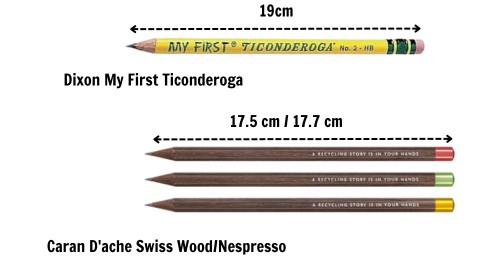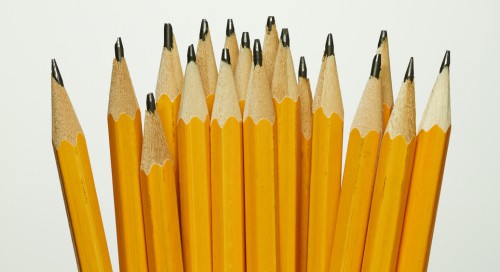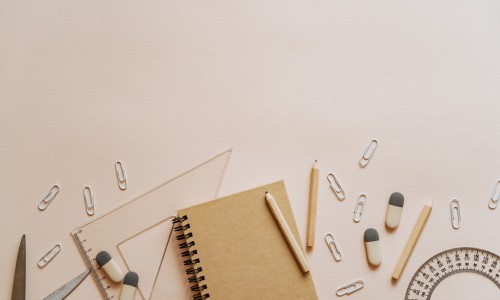Since its introduction in the 1660s, the pencil industry has flourished, so much so that it’s not hard to see why pencils have become a staple writing instrument besides pens. However, most people usually don’t take heed of how long is the average pencil, as they tend to focus on graphite colors and sizes of lead instead.
Technically speaking, almost all new pencils are produced with a common length—about 7 inches or 17.5 cm. In addition, a half-inch eraser is attached to the end of the pencils, so the total measurement is 7.5 inches or 19 cm.
This average pencil size is suitable for most people to ensure a comfortable and proper grip. However, you can find other pencils with different lengths on the market. Let’s find out more!
Table of Contents
The Standard Length
How many inches is a pencil? The majority of wooden pencils you can find on the market are around 7 inches (17.5 cm) without an eraser and 7.5 inches with an eraser. As for the average pencil width, you’d find most to measure 0.3 inches—give or take.
However, the standard length for a number 2 pencil can vary depending on its targeted audience:
- Pencils designed for children, for example, must be shorter to accommodate smaller hands. Hence, their length would average around 5–6 inches.
- Meanwhile, writing tools for carpenters need to be longer so the workers can have a firmer grip. In this case, the pencil can reach up to 8 or 9 inches.
Type of Pencils and Their Lengths
| Wooden Pencil | Mechanical Pencil | |
| Materials | Wood | Plastic and metal |
| Length size of a pencil | Around 7.5 inches | 5.5-6.5 in inches |
| Weight | 0.2-0.3 ounces | About 0.5-2 ounces |
| Lead size | Around 2 mm | 0.2-5.6 mm |
1. Wooden Pencil
As mentioned above, a normal pencil with a standard 2-mm lead would be 7.5 inches long and 0.2-0.3 ounces heavy. However, it’s not that uncommon to come across outliers to this average pencil length:
- Golf pencils produced by Dixon only measure 3 to 3.5 inches.
- In 2017, the longest pencil was produced. Made by BIC, it boasted an impressive 3582-foot length (1091.99 meters).
- Held by an Indian man, the record for the shortest pencil ever is only 0.19 inches (5 mm) long. That said, if you’re counting profesionally-made pencils only, the shortest one would be 0.7 inches (17.5 in mm).
Note that the dimensions of a pencil will be shorter after sharpening.
2. Mechanical Pencil
Unlike their wooden counterparts, mechanical pencils don’t really have standard length, meaning they can vary from brand to brand. However, most would fall within the range of 5.5-6.5 inches (or 14 to 16.5 in cm), as demonstrated in the list below
- BIC: 6.1 inches
- Pen Gear: 6.5 inches
- Sparkle Twister: 5.6 inches
- Muji: 5,83 inches
- Alvin Draft-Matic: 5.5 inches
Again, there can be outliers to the aforementioned average range. For example, the Zebra Techo TS-3 only measures 4 inches in length, whereas the Staedtler Mars Technico can reach up to 7.8 inches.
As these pencils don’t need sharpening, their length stays the same throughout their lifespan.
Pencil Lengths
When thinking about “how tall is a pencil,” you’ll also have to consider that wooden ones will gradually become shorter as they get sharpened. On average, each sharpening will shave off 0,2 inch (0.5 cm) from the pencil.
As many manufacturers pre-sharpen their products, you can expect these pencils to not be at their longest. That said, you can refer to the list of pencil maximum lengths from various manufacturers to get a general idea of their product’s dimensions.
1. Factory Sharpened
- Dixon My First Ticonderoga: 19cm
- Caran D’ache Swiss Wood/Nespresso: 17.5 cm / 17.7 cm
2. Unsharpened
- Dixon Ticonderoga: 19cm
- Tombow Pencilsk Around 17.6cm
- Amazon Basics: 17.7cm
- Faber Castell 9003: 17.5cm
- Colleen No.710: 18.9cm
- Eberhard Faber Mongol 482/Velvet 3557: 19.1cm/18.9cm
- Naturaj Stripes: 17.8cm
- Palomni Blackwing Eras: 20cm
- Mitsubishi Uni Velvet Touch: 17.7cm
Choosing the Right Pencil Length
1. Age
Although manufacturers choose the average length of a pencil, this figure isn’t suitable for all people. Kids from grades 1-3 have small hands, so 5-inch pencils would be better for them. Children in kindergarten, meanwhile, will fare better with 3.5-inch goft pencils.
2. Purpose
Writing on rough surfaces will require a stronger grip on the pencil. As such, you’ll need a longer pencil, preferably around 8 or 9 inches.
Likewise, work that requires precision, such as drawing intricate illustrations, will call for mechanical pencils with longer lead sleeves, which ultimately translates to bigger writing tools. In this case, a pencil with a length of at least 6 inches will suffice.
3. Portability
If you value portability above all else, feel free to choose a shorter-than-average pencil, so long as you can grip it comfortably. A mini 4-inch mechanical pencil or a 3.5-inch goft pencil will be an excellent choice in this case.
FAQs
How long does a pencil last?
On average, a wooden pencil can draw a straight line for 35 miles before running out. So, if well preserved, it can last for up to 25 years.
A mechanical pencil, on the other hand, can theoretically last forever since you can just put new lead into it.
How does the length of a pencil affect its performance?
The pencil’s length can greatly impact the gripping comfort and balance. Generally, a longer pencil will offer a more comfortable grip and precise control.
That said, the ideal pencil measurements for efficient writing will ultimately depend on your hand size, with small hands favoring shorter writing tools.
Conclusion
Knowing how long is the average pencil allows you to pick suitable pencils. The 7.5-inch length is usually the standard in unsharpened products. For sharpened ones, this figure will be decreased a bit to 7 inches.
In case you don’t want to spend time sharpening a pencil, you can choose mechanical versions whose leads are refillable for continuous writing.
If you have any questions relating to pencils, don’t be shy to comment. We are always ready to hear your voice.

Art has always been a part of my life; it influences my upbringing and later my career choice. For me, it is always a part of my parenting technique. So for whichever purpose that you come to art, you can start here with us.






